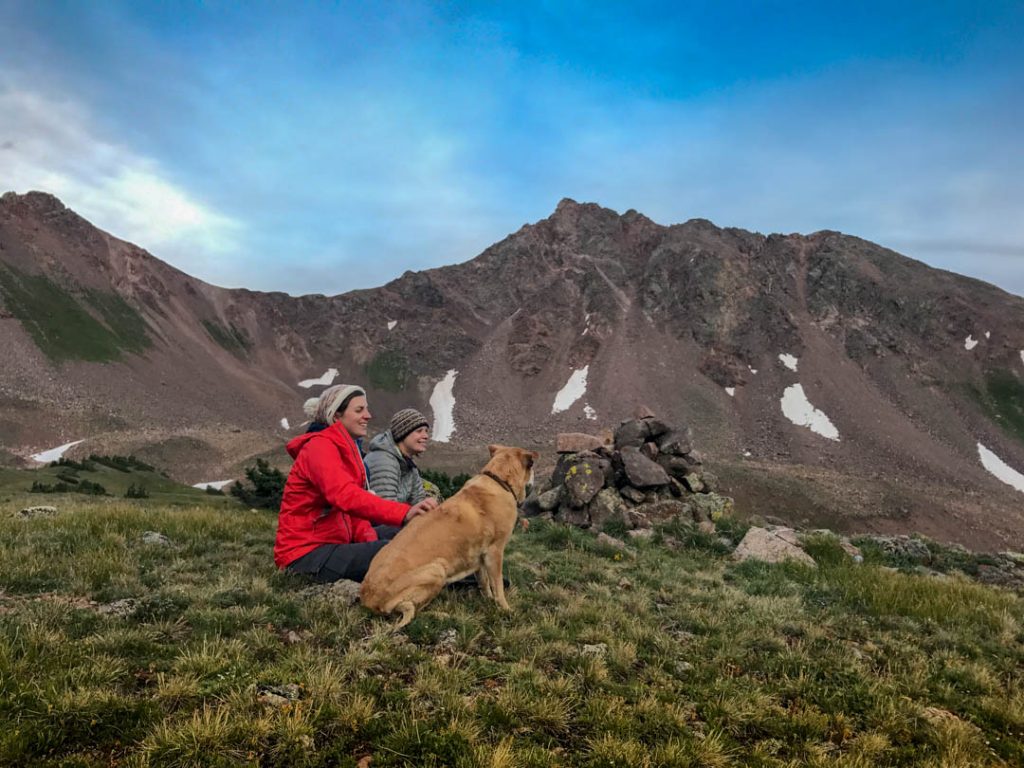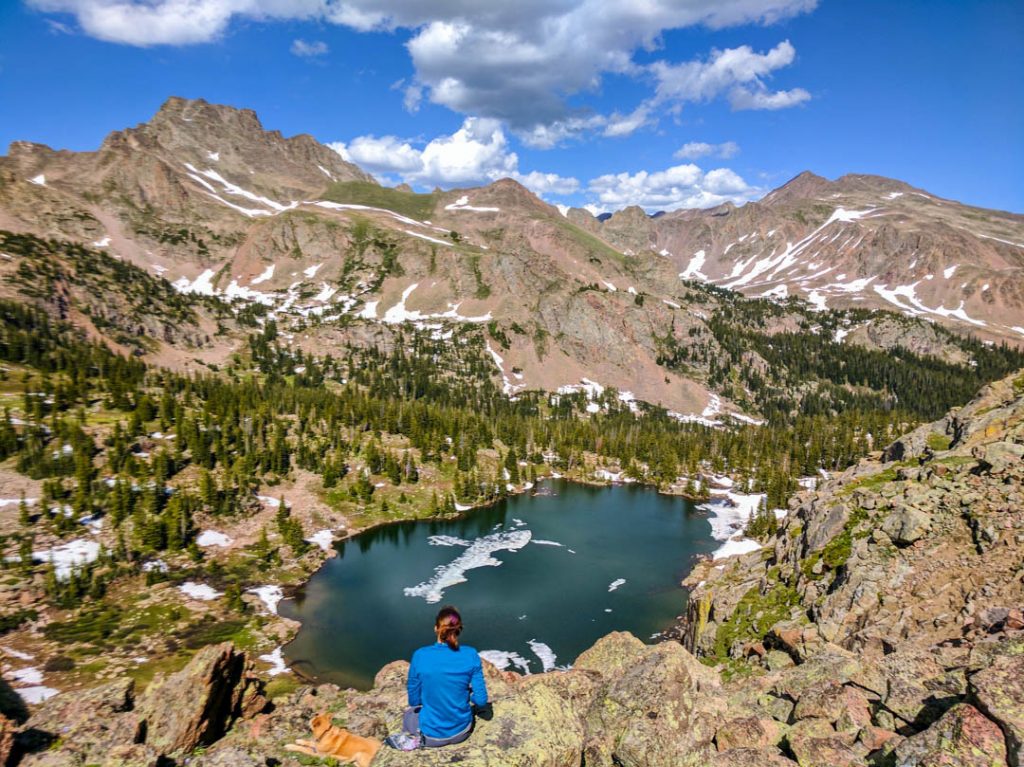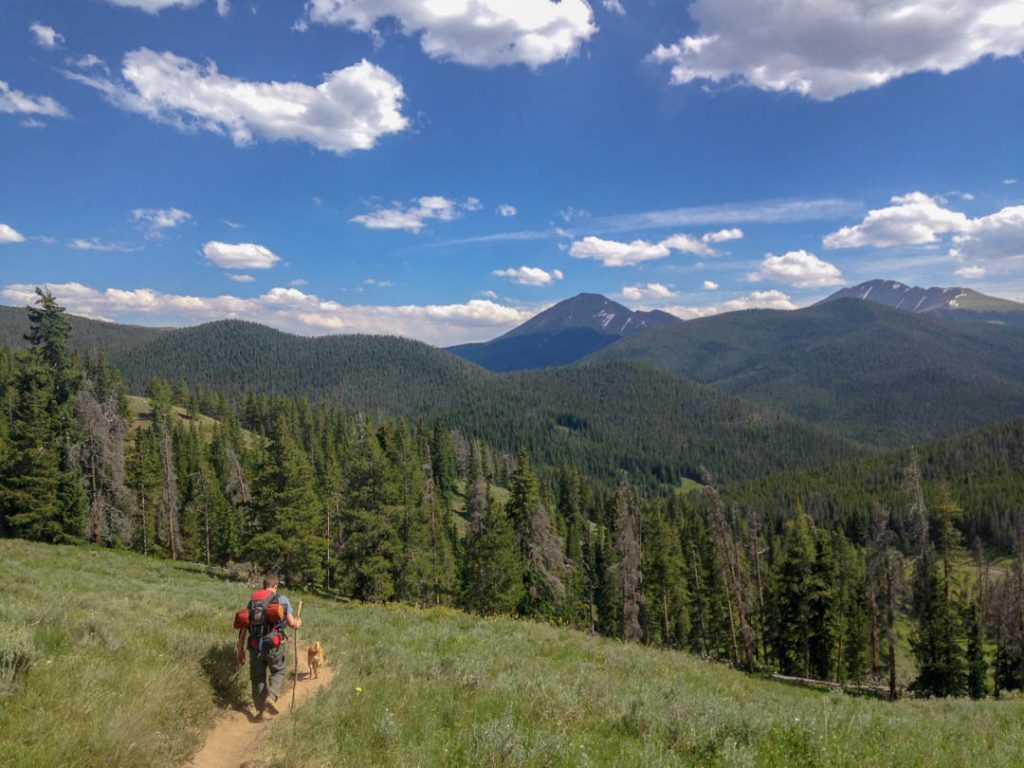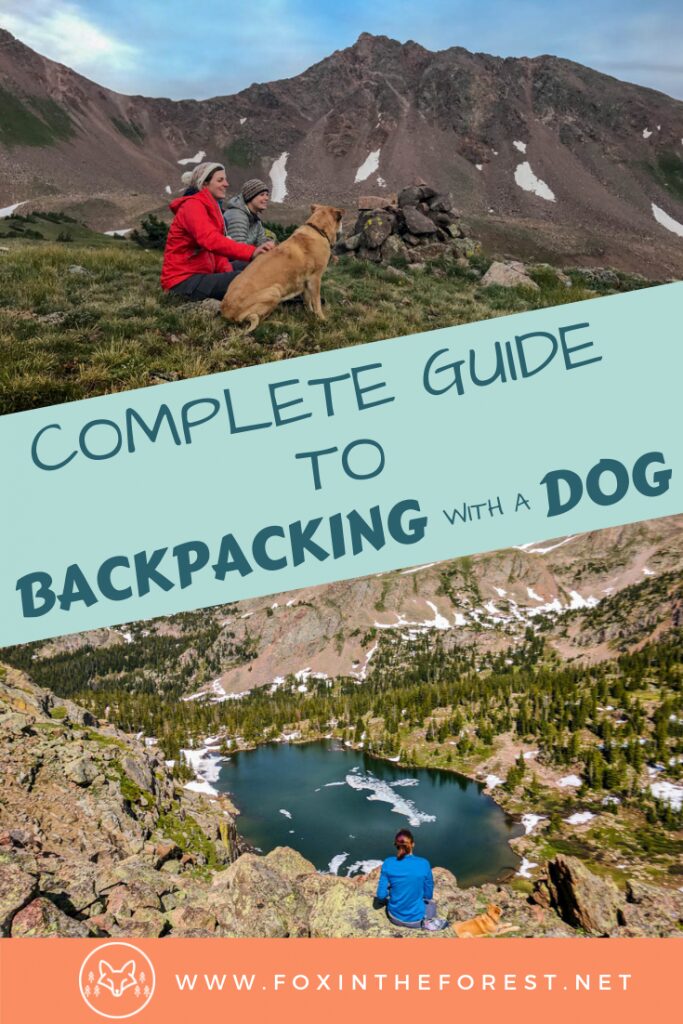Last Updated on November 5, 2021 by foxintheforest
Hitting the trail with your four-legged friend is one of the most rewarding outdoor activities. There’s something nice about snuggling up to your pup after a long, hard day of hiking. However, just like people, dogs need some prep before heading out on a backpacking trip. Get fido trail ready with these backpacking tips for dogs.
Choosing Dog-Friendly Trails
Before you even step foot on the trail, you’ve got to take your furry friend into account when you’re planning your backpacking route. First, you want to make sure that the trail is dog-friendly. This doesn’t just apply to trail rules and regulation, but take a look at the terrain. Is your pup ready to handle rocky trails? Is scrambling involved? What are the current trail conditions like? All of these things are important when selecting a route to go backpacking with your dog.
Wanna learn more about backpacking? Check out these resources
- Everything you need to know for your first backpacking trip
- How to plan a backpacking trip
- Everything you need to know about backpacking gear
- How to make your own DIY backpacking meals
Is Your Dog Even Interested in Backpacking?
It may be your dream to have your furry friend accompany you on the trail, but your dog may not enjoy backpacking. My friend’s pup, Murray, for example, is more of a city dog. He gets extreme anxiety when he’s away from home and this is compounded when we are out on the trail. You know what? That’s perfectly okay.
Not all dogs were meant to spend days on end outdoors. Before you commit to backpacking in the wilderness with your dog, try some simple day hikes or an overnight camping trip close to home. If you find your pup doesn’t love the wilderness, that’s totally okay, consider getting a Rover (a dog sitter that will even watch your dog from your own home) the next time you hit the trail.
Does Your Dog Behave?
It is essential that you have an honest conversation about your dog’s behavior before you hit the trail. So Fido may love trail time, but if your dog runs around chasing wildlife, reacts aggressively on a leash and generally doesn’t listen to your commands then you may want to consider leaving your dog at home.
Not everyone loves dogs. Some people have had traumatic experiences with dogs and others are allergic. By being a disrespectful pet owner, you are putting everyone else at risk. Do not take your dog backpacking if:
- Your dog is reactive on a leash. Most trails require animals to be leashed
- Your dog does not listen. If your dog cannot come, stay, leave it or ignore distractions, the trail is not the right place for your pup.
- Fido is prone to chasing wildlife or won’t stay on the trail

What if Your Pup Isn’t Trail-Ready?
Your best friend may not quite be obedient enough or disciplined enough to hit the hiking trail. That doesn’t mean your dog will never be able to join you for a backpacking trip. Consider spending time training your dog to be trail-ready. Train your dog in an area with plenty of distractions and figure out what motivates your pet.
For Nina, it’s food. She’s learned countless commands by using tiny training treats as a motivator. She will stay, come when called, leave distractions alone, and even knows to “stay close” which means stay within reaching distance of us.
Bump training sessions from distracting areas to an actual hiking trail before you go backpacking with your dog.
How to Prepare Your Dog for Their First Backpacking Trip
Now that your dog is disciplined and wants to hit the trail, it’s time to train! Dogs who aren’t used to getting extensive amounts of physical activity each day may have issues hiking along backpacking routes. Go on a few training hikes with your pup that mimic the number of miles you would cover backpacking with your dog.
See how your dog does that evening and the following day. If you notice any soreness or hesitation, see a vet.
Vaccinations for Backpacking with a Dog
Before you hit the trail with your best bud, be sure to check in with your vet. Dogs should be cleared medically for any strenuous activity. Furthermore, there may be diseases or viruses that are prevalent in your area. For example, here in Colorado, Lepto is a common outdoor disease. Many city dogs don’t regularly get vaccinated for Lepto, because the virus is spread from fox pee.
Don’t forget about routine medication such as heartworm prevention, flea, tick, and mosquito prevention. If you plan on having your dog carry a pack, be sure to get the all-clear from your vet.
Backpacks for Dogs
I have very mixed feelings about backpacks for dogs. Depending on the breed, age, and size of the animal, weighing down a dog backpack might not be the best move. You can cause damage to your pet’s back, the pack could be fitted incorrectly for your dog’s body type and cause lesions and sores.
If you do opt to use a dog backpack, make sure the pack fits correctly. Go on a few training hikes with the bag so your dog can get used to the weight. Always weight the pack evenly and don’t over-do it. When Nina used to wear a pack she would carry a few of her own meals and an item or two of ours to balance the weight. She stopped wearing her pack at eight years old, despite the fact that she is in excellent health when we noticed her start to struggle.

Other Camping Gear for Dogs
Camping gear for dogs is typically gimmicky and not really necessary (not to mention it’s pretty expensive). However, there are several human camping and backpacking items that work perfectly well for pets too! Not to mention you can share. Here’s a look at a few things you’ll take with you when you’re backpacking with a dog:
Hiking Gear for Dogs
Hiking gear for dogs is similar to camping gear for dogs, it’s largely unnecessary. I would advise against dog hiking shoes. Just like people, dogs have differently shaped paws. Dog hiking booties can cause painful injury such as rubbing, dislocated claws, and in extreme cases death by overheating. We will discuss more on paw protection later.
Aside from a leash, water, poop backs (or a shovel to bury waste), and first aid supplies, you don’t need any special equipment to hike with your dog.
Want to learn more about hiking with your dog? Check out these posts:
Trail Etiquette for Dogs and Dog Owners
While you’re out on the trail backpacking with your dog, keep other trail users in mind. If your dog is allowed off-leash, be sure your dog stays close to you (or hold your dog) when approaching others. It’s never okay to let your dog run up to someone and shout “It’s okay, he’s friendly.” The other person may not like dogs.
When passing and interacting with other dogs, always lead by example. Keep your pup close or leashed and put yourself between you and your fury friend.
Don’t encourage or allow your dog to chase wildlife or wander off trail. This not only harms the environment, but it could also be potentially dangerous for both you and your animal.
Lastly, always listen to rangers and volunteers. You may not like what they have to say, but rules are rules.
Backpacking with Your Dog on a Leash
Okay, so I’ll be transparent here, I hate hiking with my dog on a leash. Nina is an exceptional dog in that she is always under the command of either John or I and doesn’t even need a leash to be walked around the neighborhood. I’d be lying if I said I have never been stopped by a ranger and asked to put my dog on a leash (or gotten a ticket for it). But alas, rules are rules.
The only time I would okay breaking any regulation is if you and your dog are traveling in an area where a fall could cause injury or worse for you and your dog.
Hiking with your dog on a leash can be a hands-free event. Use a small wire gate carabiner to attach the dog to the waist belt of your pack – enabling you to hike hands-free (and still use your poles).
Backpacking with a Dog in Hot Weather
Many dogs are exceptionally sensitive to heat. A relatively mild day to you can feel like an inferno to your pup, especially if you’re backpacking over rough terrain and your dog is wearing a pack. Try to hike in the cooler hours of the morning or evening. Opt to take an extended lunch, or move slowly during the hottest parts of the day. Your pup will appreciate the rest and reprieve from the sun.

How to Protect Your Pooch’s Paws
My dog and I have completed over 120 miles of the Colorado Trail together. During one section, she completely walked her paws off…literally. The sharp pebbles gave her tiny cuts on her paws and throughout the night she chewed the top layers of skin completely off, exposing raw skin underneath. We were completely unprepared, and she couldn’t walk. Fortunately, we were near a road and were able to rescue ourselves, but paw protection is vital for your pet.
I recommend using Musher’s Secret, a paw salve that protects your dog’s feet over rough terrain. Inspect your dog’s paws every few hours to ensure there are no tiny tears or scrapes. If you spot one, address it immediately by creating an impromptu bootie out of a child’s sock and medical tape. Keep the wound as clean as possible and wash it out as soon as you get home. If you detect an infection or your dog is favoring the paw heavily, see your vet immediately.
Dealing with Dog Poop on the Trail
Dog poop on a hiking trail is utterly unsightly. You wouldn’t leave your own poop in the middle of the trail, so why leave your dog’s there. If you are not comfortable carrying poop, dirty toilet paper, or other items part of everyday bodily functions, simply avoid hiking and backpacking until you are.
For dog dealing with dog poop while backpacking, you can bury it, just as you would your own. If you are in a sensitive environment such as the desert or high alpine, pack out the poo. You should be doing this for yourself anyway using a special bag designed to carry out, so bring an extra one for your pup too. Part of being outside in some of the most beautiful environments is carrying your own waste, so if you can’t handle it, then please stay home.
What to Know about Camping with Your Dog in the Wilderness
The big difference between hiking and backpacking with a dog is spending the night far from civilization. For most animals, that’s not a problem, but some dogs may not like being in a tent. They may growl or bark at strange noises, not be able to get comfortable or keep you up at night.
Always make sure you have some water in the tent for your pup and keep an extra layer or two handy to wrap up your furry friend should the get cold. If your dog likes to wander, purchase a little keychain light that you can attach to your dog’s collar or harness to keep tabs on them. It may take a few nights to get used to tent life, but your dog should settle into a routine.
Thru-Hiking with a Dog
Some things are better done without a dog, thru-hiking is one of them. Due to vast amounts of regulations, long water carries, and the stress and strain thru-hiking puts on your own body, I wouldn’t advise taking your pup on a thru-hike. In fact, on many trails, such as the PCT, there are areas that don’t allow dogs.
Shorter thru-hikes (think less than a month) may be possible with the right dog and the right owner, but expect to carry more weight, stop more often, and have difficulty hitching rides to resupply.
Backpacking and hiking with an Elderly Dog
Seeing a dog get older can be a bit depressing, especially if your dog spent the majority of its life backpacking, hiking and in the outdoors. Nina is currently 12 years old and in great health. She has minimal arthritis and as far as we can tell, she can still join us for backpacking trips. However, we’ve had to adjust our plans with her. If your vet has cleared your elderly dog for backpacking activities keep these tips in mind.
- Go early. Older dogs have trouble with the heat, so start your day early, and plan to take a long rest during the heat of the day.
- Go slow. Some older dogs may need help over steep inclines or walk slower than they usually did. Be patient.
- Consider something easier. Perhaps you are used to backpacking 20 miles a day, your older dog may prefer eight. Keep mileage and difficulty lower so they can still get out and enjoy themselves.
- Plan for downtime. Don’t hike during every minute of daylight hours. Take it slow, take breaks, and enjoying seeing the world through your older dog’s eyes.
With these backpacking tips for dogs, you’re ready to hit the trail with your four-legged friend this season. Enjoy the rewards of spending time with your best friend on the trail. Happy tails mean happy trails!


